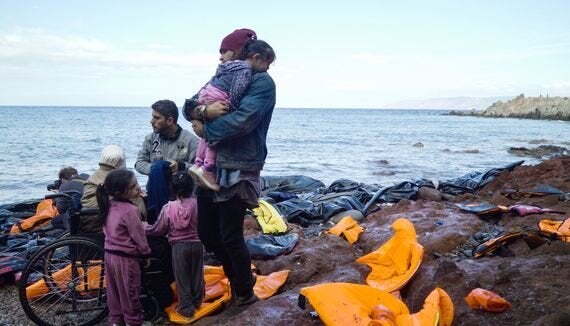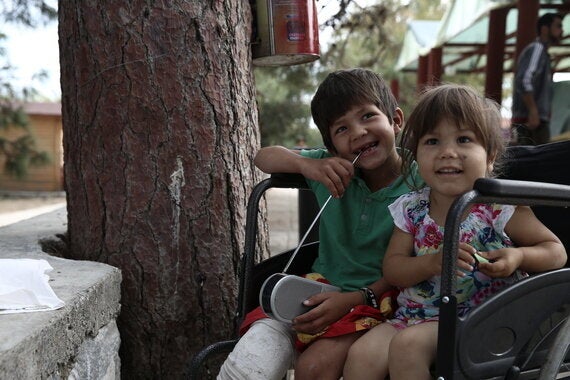In my last blog I described what it was like when we first came into contact with the people who had made the journey via dinghy to the shores of Lesbos, Greece. This was our first close up encounter with Europe's 'refugee crisis', and although we knew people were making this desperate voyage by boat it was sobering to see it in real life, to witness the mixture of fear and panic in people's eyes.
The crew and I stayed in Mithymna for four days, watching new boats coming in each morning, and each day we seemed to film less than the previous one because we became so involved in helping people, along with all the other volunteers. We tried our best to remain professional, but when people were visibly tired, cold and frightened, reaching out for a helping hand or passing a child over to us, we had to put the filmmaking equipment aside.

Above: me helping a family in Lesbos (Image: Dan Ciufo)
From the boats, people would dry themselves and their few possessions while looking to local volunteers for guidance. Then they would walk towards the harbour where a small cluster of tents gave people the chance to collect food and new clothes. It is at this point that registration forms were handed out, so the police and local authorities can keep tabs on anyone arriving or departing.
Most of the refugees landing on the eight miles of coast east of Mithymna are gathered up by buses and taken to holding camps, though some choose to walk. When they arrive in the camps they are given tickets and asked to wait for more coaches to take them to Mytilene, the ferry and Athens beyond.
It is at this point that we could see the initial euphoria of the refugees begin to wane. They are mostly optimistic, and talkative when you speak to them - which we will show in our final documentary - but there was also a new tension present, born out of the waiting. However, the wait is necessary as it's the only way the authorities and aid agencies can cope with the volume of people.
We eventually left Mithymna to follow the coaches taking people to the processing camps in Mytilene, and once there we knew we had to visit the camp at Pikpa. After many dead ends, awkward reverses and backseat driving, we finally found it, situated at the top of a small dirt track. Pikpa was set up to house, feed and look after unaccompanied minors and the whole place had an incredible youthful energy. The children we met had an optimism which we all found inspiring, especially given the sadness and loss they had endured.

Above: children at the Pikpa camp (Image: James Alexander)
After spending the day surrounded by child refugees, there was a surprise visit from Alexis Tsipras, the Greek Prime Minister. We left feeling at ease, knowing that the camp was on people's radar and that there were plenty of compassionate people there to help.
We booked ourselves and our van - good old Vinnie Vito - onto the ferry to Athens. This was the same ferry we had seen leave a week earlier, and we enjoyed our nine-hour journey which passed quickly while chatting to some of the 2000 or so refugees lucky enough to be leaving Lesbos.
The atmosphere was one filled with joy. We were quickly learning that departures and arrivals always seem to be met with so much hope.
We felt sad to leave Lesbos and the inhabitants who, from what we saw, have big hearts. They helped all the people arriving on their shores, but would Athens and mainland Europe be quite as welcoming?